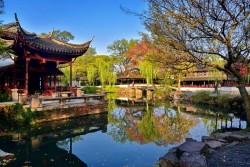You have no items in your shopping cart.


Introducing Tiger Hill
Tiger Hill is a renowned tourist destination located northwest of downtown Suzhou. Tiger Hill is famed for its architectural splendor and historical significance. Spanning a remarkable 475.9 hectares (1,175 acres), the hill is revered as one of the most beautiful spots in Jiangsu province. Its beauty even captivated the renowned Song Dynasty (960-1279) poet Su Shi (1037-1101), who famously remarked, “To see Suzhou and not Tiger Hill is to only see half the picture.”
The hill’s name is inspired by its resemblance to a crouching tiger, and legend claims that a white tiger appeared on the hill to guard the tomb of King Helü (阖闾) of Wu, who, according to historical records, was laid to rest here during the Spring and Autumn period (770-476 B.C.).
Among its many other attractions, what truly sets Tiger Hill apart are its undisputed stars: the Tiger Hill Pagoda (Yunyan Pagoda) and the Sword Pool. The pagoda, with a history spanning over 1,000 years, is known as the “Second Leaning Tower on Earth” and stands as a symbol of ancient Suzhou. The Sword Pool, said to conceal the tomb of King Helü, remains an unsolved mystery after 2,500 years, adding an air of intrigue to the location.
But Tiger Hill is more than just ancient wonders; the energy of its celebrations, from the colorful Flower Exhibition to the lively temple fair, creates an unforgettable cultural experience, making it a must-visit in the Lower Yangtze region.
Tiger Hill Fast Facts
• AKA: Hu Qiu, Surging Sea Hill
• Chinese Name: Huqiu 虎丘
• Best Time to Visit: All year around
• Recommended Visiting Hours: 2 - 3 x hours
• Things to Do: Photography, Architecture, History and Culture, Buddhism
• Opening Hours: 7:30 – 18:00 (Mar – Oct), 7:30 – 17:30 (Nov – Apr)
• Entrance Fee: CNY60 (Jan – Mar, June, Nov – Dec), CNY70 (Apr – May, July – Oct)
• Address: 8 Huqiushan Road, Gusu District, Suzhou, Jiangsu Province
What to Expect at Tiger Hill
If you’re fascinated by Chinese style, gardens, and spirituality, then this site is right up your alley. The look and feel of the area, with everything so picturesque and historic, will not leave you disappointed. Don’t forget your camera – countless unforgettable moments await!
How to Get to Tiger Hill
• By Bus: Take bus 1 to Liuyuan Station.
Additional Travel Advice on Tiger Hill
• Tourist Center is at the north entrance of the scenic area, offering multiple services: Information Inquiry, Baby stroller /Phone charger/Wheelchair lending, Free Wi-Fi, etc.
• Annual Artistic Flower Show usually takes place from March to May. And Autumn Temple Fair will be held in from September to October.